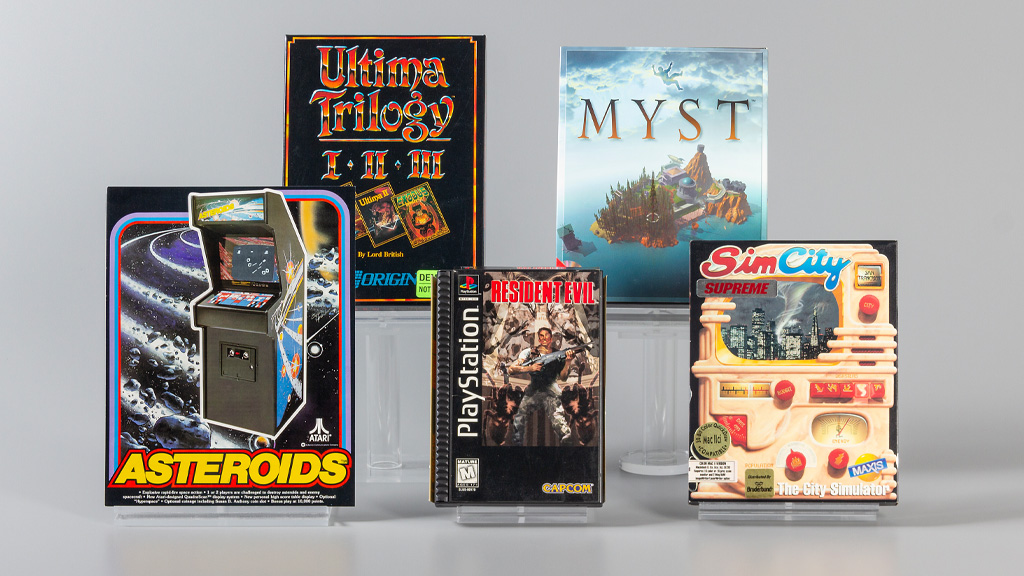
The Strong National Museum of Play has inducted Asteroids, Myst, Resident Evil, SimCity, and Ultima into the World Video Game Hall of Fame. Each video game significantly influenced video game history and pop culture, and is enshrined in the World Video Game Hall of Fame rotunda, which is part of the ESL Digital Worlds exhibit.
Atari’s Asteroids, released in 1979, featured intense sound effects, unique graphics, and challenging gameplay in a space setting. The video game supplanted Space Invaders in arcades and sold more than 70,000 arcade units. The home version of the game, playable on the Atari 2600, became popular as well.
“Through endless variants and remakes across dozens of arcade, home, handheld, and mobile platforms, Asteroids made a simple, yet challenging game about blasting rocks into one of the most widely played and influential video games of all time,” says Jeremy Saucier, Assistant Vice President for Interpretation and Electronic Games at the Strong Museum.

Released in 1993, Myst sold more than 6 million copies in the 1990s. The video game utilized early CD-ROM technology, and players entered a world of puzzles and vistas. The slow loading times, a result of the CD-ROM technology, paired with the slow-paced, contemplative style of the game for a unique level of player immersion.
“Few other games can match Myst’s ability to open imaginative worlds,” says Kristy Hisert, Collections Manager at the Strong Museum. “It was a work of artistic genius that captured the imagination of an entire generation of computer game players, and its influence can be seen in many of today’s open-world games.”
Resident Evil, known as Biohazard in Japan, popularized the survival horror genre after Capcom released it in 1996. Created by game director Shinji Mikami, the game sparked a large media franchise — as of 2022, the films based on the franchise have collectively grossed more than $1.2 billion. Resident Evil demonstrated that video games could evolve into entertainment for teenagers and adults.
“Resident Evil‘s combination of cheesy B-movie dialogue, engrossing gameplay, and chilling suspense made it a favorite of gamers searching for more mature video games, and it helped establish one of gaming’s most enduring franchises,” says Lindsey Kurano, Video Game Curator at the Strong Museum.
SimCity was released by Maxis in 1989 and expanded the audience for video games, as the city-building simulator appealed to a wide range of kids and adults. The video game inspired several city-building simulations and strategy games like Command & Conquer and Age of Empires. The game also generated sequels and offshoots, including 2016 World Video Game Hall of Fame inductee The Sims.
“Simulations are some of the oldest forms of video games, but few have had the popularity, influence, or staying power of SimCity,” says Aryol Prater, Research Specialist for Black Play and Culture at the Strong Museum. “At a time when many people thought of video games in terms of arcade shooters or console platformers, SimCity appealed to players who wanted intellectually stimulating fun on their newly bought personal computers.”
The final 2024 inductee, Ultima: The First Age of Darkness, was designed by Richard Garriott and released in 1981. The game helped define the computer role-playing genre by combining role-playing mechanics, a large fictional world, and both fantasy and science fiction themes. Ultima’s gameplay inspired a gaming franchise and other role-playing games.
“Ultima helped define the computer role-playing game genre,” says Andrew Borman, Director of Digital Preservation at the Strong Musuem. “Although it may not be a household name, the game and the series it spawned are legendary among role-playing game fans and game developers around the world.”
The five games were chosen from a group of finalists that included Elite, Guitar Hero, Metroid, Neopets, Tokimeki Memorial, Tony Hawk’s Pro Skater, and You Don’t Know Jack.
For more information on the World Video Game Hall of Fame, established in 2015, visit museumofplay.org.
Trending Products











